Fosca Giannotti
Interpretable and Fair Mechanisms for Abstaining Classifiers
Mar 24, 2025Abstract:Abstaining classifiers have the option to refrain from providing a prediction for instances that are difficult to classify. The abstention mechanism is designed to trade off the classifier's performance on the accepted data while ensuring a minimum number of predictions. In this setting, often fairness concerns arise when the abstention mechanism solely reduces errors for the majority groups of the data, resulting in increased performance differences across demographic groups. While there exist a bunch of methods that aim to reduce discrimination when abstaining, there is no mechanism that can do so in an explainable way. In this paper, we fill this gap by introducing Interpretable and Fair Abstaining Classifier IFAC, an algorithm that can reject predictions both based on their uncertainty and their unfairness. By rejecting possibly unfair predictions, our method reduces error and positive decision rate differences across demographic groups of the non-rejected data. Since the unfairness-based rejections are based on an interpretable-by-design method, i.e., rule-based fairness checks and situation testing, we create a transparent process that can empower human decision-makers to review the unfair predictions and make more just decisions for them. This explainable aspect is especially important in light of recent AI regulations, mandating that any high-risk decision task should be overseen by human experts to reduce discrimination risks.
Deferring Concept Bottleneck Models: Learning to Defer Interventions to Inaccurate Experts
Mar 20, 2025Abstract:Concept Bottleneck Models (CBMs) are machine learning models that improve interpretability by grounding their predictions on human-understandable concepts, allowing for targeted interventions in their decision-making process. However, when intervened on, CBMs assume the availability of humans that can identify the need to intervene and always provide correct interventions. Both assumptions are unrealistic and impractical, considering labor costs and human error-proneness. In contrast, Learning to Defer (L2D) extends supervised learning by allowing machine learning models to identify cases where a human is more likely to be correct than the model, thus leading to deferring systems with improved performance. In this work, we gain inspiration from L2D and propose Deferring CBMs (DCBMs), a novel framework that allows CBMs to learn when an intervention is needed. To this end, we model DCBMs as a composition of deferring systems and derive a consistent L2D loss to train them. Moreover, by relying on a CBM architecture, DCBMs can explain why defer occurs on the final task. Our results show that DCBMs achieve high predictive performance and interpretability at the cost of deferring more to humans.
Mathematical Foundation of Interpretable Equivariant Surrogate Models
Mar 03, 2025Abstract:This paper introduces a rigorous mathematical framework for neural network explainability, and more broadly for the explainability of equivariant operators called Group Equivariant Operators (GEOs) based on Group Equivariant Non-Expansive Operators (GENEOs) transformations. The central concept involves quantifying the distance between GEOs by measuring the non-commutativity of specific diagrams. Additionally, the paper proposes a definition of interpretability of GEOs according to a complexity measure that can be defined according to each user preferences. Moreover, we explore the formal properties of this framework and show how it can be applied in classical machine learning scenarios, like image classification with convolutional neural networks.
Multi-Perspective Stance Detection
Nov 13, 2024

Abstract:Subjective NLP tasks usually rely on human annotations provided by multiple annotators, whose judgments may vary due to their diverse backgrounds and life experiences. Traditional methods often aggregate multiple annotations into a single ground truth, disregarding the diversity in perspectives that arises from annotator disagreement. In this preliminary study, we examine the effect of including multiple annotations on model accuracy in classification. Our methodology investigates the performance of perspective-aware classification models in stance detection task and further inspects if annotator disagreement affects the model confidence. The results show that multi-perspective approach yields better classification performance outperforming the baseline which uses the single label. This entails that designing more inclusive perspective-aware AI models is not only an essential first step in implementing responsible and ethical AI, but it can also achieve superior results than using the traditional approaches.
A linguistic analysis of undesirable outcomes in the era of generative AI
Oct 16, 2024
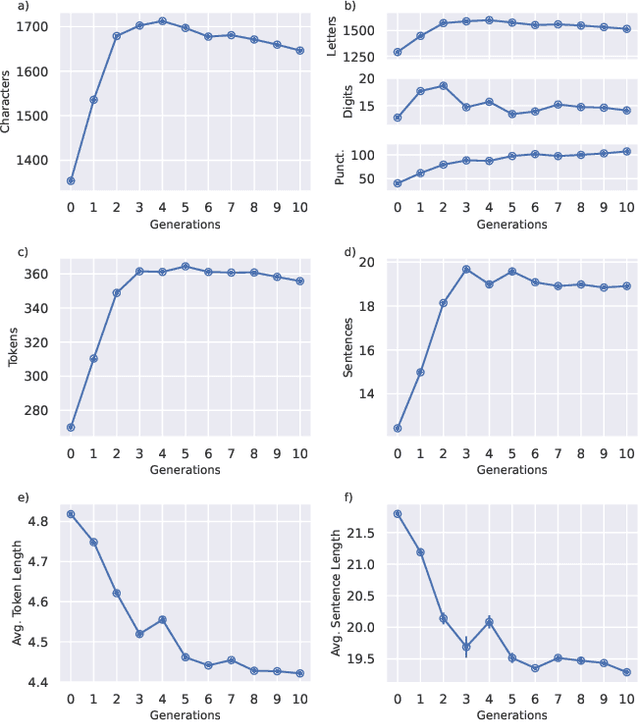
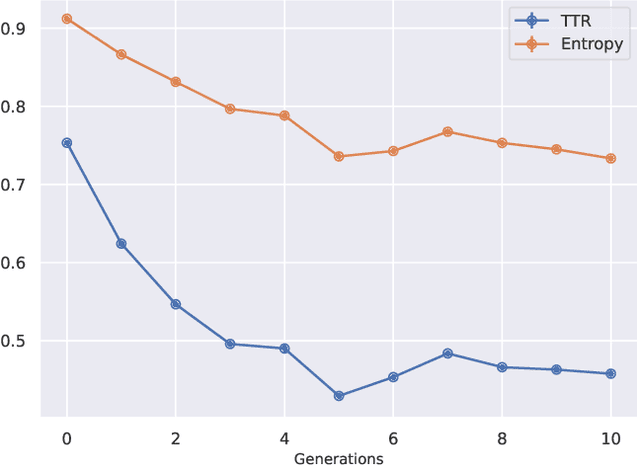
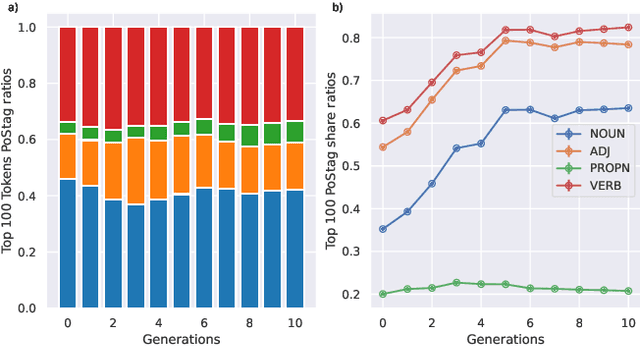
Abstract:Recent research has focused on the medium and long-term impacts of generative AI, posing scientific and societal challenges mainly due to the detection and reliability of machine-generated information, which is projected to form the major content on the Web soon. Prior studies show that LLMs exhibit a lower performance in generation tasks (model collapse) as they undergo a fine-tuning process across multiple generations on their own generated content (self-consuming loop). In this paper, we present a comprehensive simulation framework built upon the chat version of LLama2, focusing particularly on the linguistic aspects of the generated content, which has not been fully examined in existing studies. Our results show that the model produces less lexical rich content across generations, reducing diversity. The lexical richness has been measured using the linguistic measures of entropy and TTR as well as calculating the POSTags frequency. The generated content has also been examined with an $n$-gram analysis, which takes into account the word order, and semantic networks, which consider the relation between different words. These findings suggest that the model collapse occurs not only by decreasing the content diversity but also by distorting the underlying linguistic patterns of the generated text, which both highlight the critical importance of carefully choosing and curating the initial input text, which can alleviate the model collapse problem. Furthermore, we conduct a qualitative analysis of the fine-tuned models of the pipeline to compare their performances on generic NLP tasks to the original model. We find that autophagy transforms the initial model into a more creative, doubtful and confused one, which might provide inaccurate answers and include conspiracy theories in the model responses, spreading false and biased information on the Web.
A survey on the impact of AI-based recommenders on human behaviours: methodologies, outcomes and future directions
Jun 29, 2024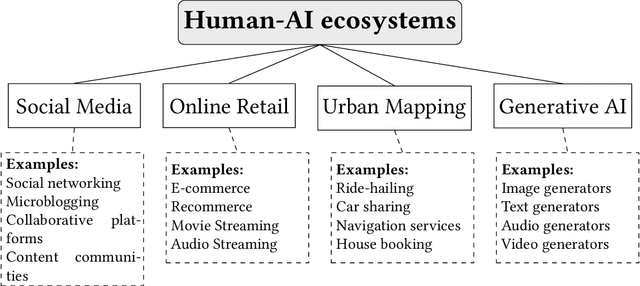
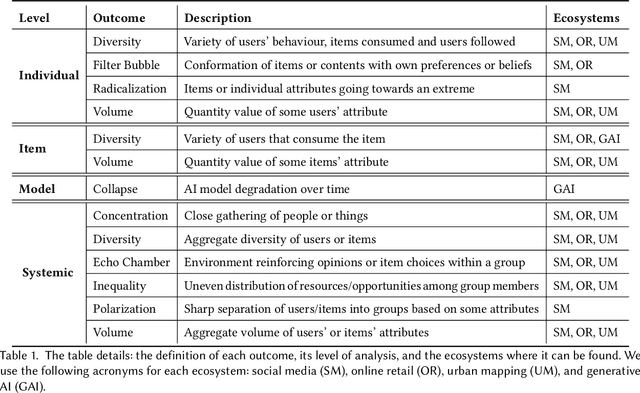

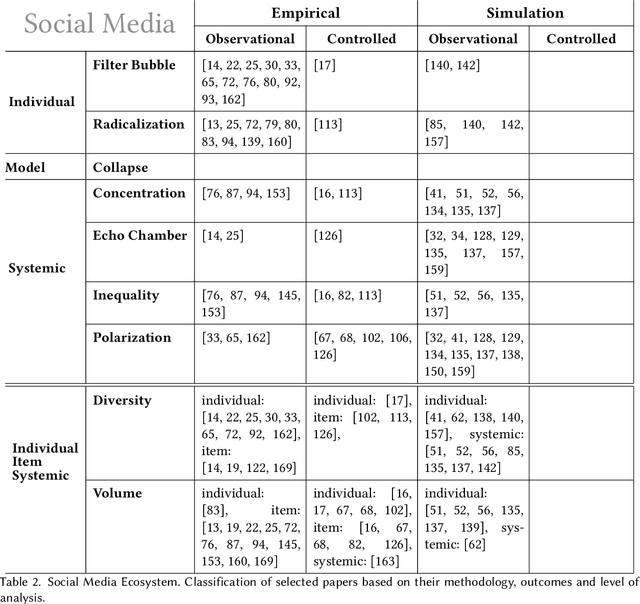
Abstract:Recommendation systems and assistants (in short, recommenders) are ubiquitous in online platforms and influence most actions of our day-to-day lives, suggesting items or providing solutions based on users' preferences or requests. This survey analyses the impact of recommenders in four human-AI ecosystems: social media, online retail, urban mapping and generative AI ecosystems. Its scope is to systematise a fast-growing field in which terminologies employed to classify methodologies and outcomes are fragmented and unsystematic. We follow the customary steps of qualitative systematic review, gathering 144 articles from different disciplines to develop a parsimonious taxonomy of: methodologies employed (empirical, simulation, observational, controlled), outcomes observed (concentration, model collapse, diversity, echo chamber, filter bubble, inequality, polarisation, radicalisation, volume), and their level of analysis (individual, item, model, and systemic). We systematically discuss all findings of our survey substantively and methodologically, highlighting also potential avenues for future research. This survey is addressed to scholars and practitioners interested in different human-AI ecosystems, policymakers and institutional stakeholders who want to understand better the measurable outcomes of recommenders, and tech companies who wish to obtain a systematic view of the impact of their recommenders.
AI, Meet Human: Learning Paradigms for Hybrid Decision Making Systems
Feb 09, 2024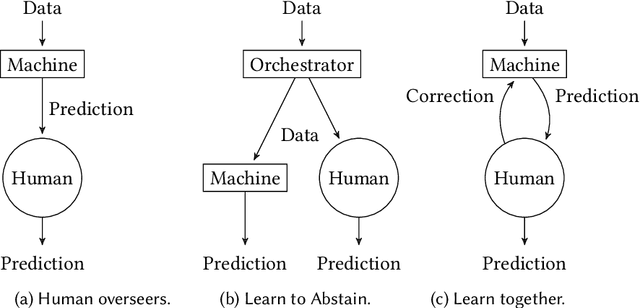



Abstract:Everyday we increasingly rely on machine learning models to automate and support high-stake tasks and decisions. This growing presence means that humans are now constantly interacting with machine learning-based systems, training and using models everyday. Several different techniques in computer science literature account for the human interaction with machine learning systems, but their classification is sparse and the goals varied. This survey proposes a taxonomy of Hybrid Decision Making Systems, providing both a conceptual and technical framework for understanding how current computer science literature models interaction between humans and machines.
HANSEN: Human and AI Spoken Text Benchmark for Authorship Analysis
Oct 25, 2023Abstract:Authorship Analysis, also known as stylometry, has been an essential aspect of Natural Language Processing (NLP) for a long time. Likewise, the recent advancement of Large Language Models (LLMs) has made authorship analysis increasingly crucial for distinguishing between human-written and AI-generated texts. However, these authorship analysis tasks have primarily been focused on written texts, not considering spoken texts. Thus, we introduce the largest benchmark for spoken texts - HANSEN (Human ANd ai Spoken tExt beNchmark). HANSEN encompasses meticulous curation of existing speech datasets accompanied by transcripts, alongside the creation of novel AI-generated spoken text datasets. Together, it comprises 17 human datasets, and AI-generated spoken texts created using 3 prominent LLMs: ChatGPT, PaLM2, and Vicuna13B. To evaluate and demonstrate the utility of HANSEN, we perform Authorship Attribution (AA) & Author Verification (AV) on human-spoken datasets and conducted Human vs. AI spoken text detection using state-of-the-art (SOTA) models. While SOTA methods, such as, character ngram or Transformer-based model, exhibit similar AA & AV performance in human-spoken datasets compared to written ones, there is much room for improvement in AI-generated spoken text detection. The HANSEN benchmark is available at: https://huggingface.co/datasets/HANSEN-REPO/HANSEN.
Social AI and the Challenges of the Human-AI Ecosystem
Jun 23, 2023Abstract:The rise of large-scale socio-technical systems in which humans interact with artificial intelligence (AI) systems (including assistants and recommenders, in short AIs) multiplies the opportunity for the emergence of collective phenomena and tipping points, with unexpected, possibly unintended, consequences. For example, navigation systems' suggestions may create chaos if too many drivers are directed on the same route, and personalised recommendations on social media may amplify polarisation, filter bubbles, and radicalisation. On the other hand, we may learn how to foster the "wisdom of crowds" and collective action effects to face social and environmental challenges. In order to understand the impact of AI on socio-technical systems and design next-generation AIs that team with humans to help overcome societal problems rather than exacerbate them, we propose to build the foundations of Social AI at the intersection of Complex Systems, Network Science and AI. In this perspective paper, we discuss the main open questions in Social AI, outlining possible technical and scientific challenges and suggesting research avenues.
Boosting Synthetic Data Generation with Effective Nonlinear Causal Discovery
Jan 18, 2023



Abstract:Synthetic data generation has been widely adopted in software testing, data privacy, imbalanced learning, and artificial intelligence explanation. In all such contexts, it is crucial to generate plausible data samples. A common assumption of approaches widely used for data generation is the independence of the features. However, typically, the variables of a dataset depend on one another, and these dependencies are not considered in data generation leading to the creation of implausible records. The main problem is that dependencies among variables are typically unknown. In this paper, we design a synthetic dataset generator for tabular data that can discover nonlinear causalities among the variables and use them at generation time. State-of-the-art methods for nonlinear causal discovery are typically inefficient. We boost them by restricting the causal discovery among the features appearing in the frequent patterns efficiently retrieved by a pattern mining algorithm. We design a framework for generating synthetic datasets with known causalities to validate our proposal. Broad experimentation on many synthetic and real datasets with known causalities shows the effectiveness of the proposed method.
 Add to Chrome
Add to Chrome Add to Firefox
Add to Firefox Add to Edge
Add to Edge